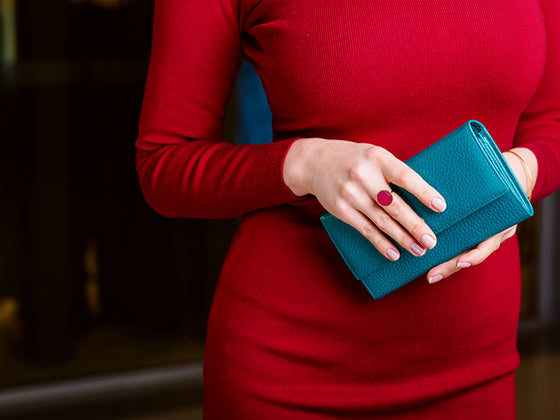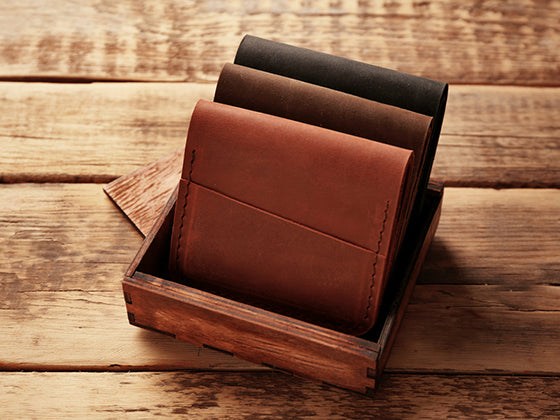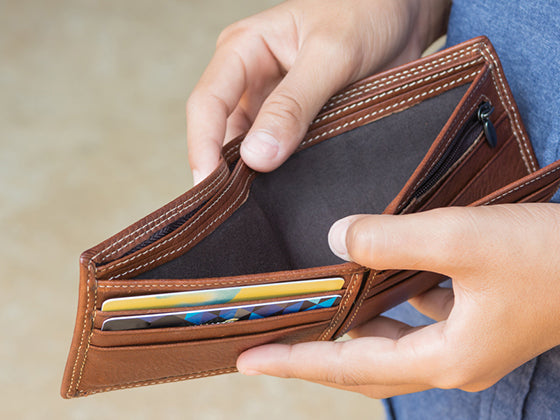We live In a high-tech world filled with comfy conveniences, including computers, laptops, smart phones, and GPS devices; yet most men sit on bulky, uncomfortable pony-express era wallets. How do we end the "battle of the bulge" and make one of our most personal accessories -- our wallet -- finally work for us instead of being a pain in the tush?
To slim down your current wallet, your best option is to periodically cull the contents of your wallet. Warning, this requires some discipline!
Paper items of fleeting value cause much wallet bulkiness: cash machine receipts, notes and business cards received from people you have long ago forgotten. Take 10 minutes once each month to prune the plethora of paper in the billfold of your wallet. Chances are you can trash 80 percent of this pile with no impact on your daily life!
Likewise, cull through your plastic items as well. You may have only a few credit cards, but you probably have lots of other plastic cards: expired gift cards and insurance cards or other cards that you never use. Junk them now!
Culling will thin your current wallet some, but to have a truly thin wallet, you'll probably need to buy a new wallet, see below.
5 Keys to a Thinner Wallet and a Comfortable Commute
1. Avoid most credit card wallet models
If you are the rare person who carries only a few cards, avoid credit card or passcase wallets as these models quickly become thick, even when only a few cards are carried in them. Credit card wallets typically have leather pouches or removable valet sections that add thickness with little benefit to you.
If you carry a large number of cards, choose the credit card wallets that feature plastic insert pages as opposed to those that have leather pouches for carrying cards. Leather pouch wallets will usually be thicker than those that feature plastic card-holder pages.
2. Consider a front pocket wallet - or putting yours in the front pocket
There are some wallets uniquely designed to fit the contours of a front pocket. Simply do a web search on "front pocket wallet" and you should find them. Alternatively, you may choose to carry your current wallet in a front pocket. This will not make your wallet thinner but may make your drive to work more tolerable than sitting on it.
3. Select bi-folds - avoid tri-fold wallets
Bi-fold wallets are always thinner than are tri-fold wallets. The accordion effect of adding an additional third fold adds 50% more thickness. Not only are tri-folds thicker, they are typically much less comfortable to sit on than bi-folds. This is because tri-folds are usually smaller in size but much thicker in girth.
4. Choose wallets that are optimized for thinness
Some companies offer innovative designs that result in thinner wallets. Find these by searching the Internet for "slim wallets" or "thin wallets" or even "thin, flexible wallets." Read and research carefully as different models feature trade-offs to achieve thinness. Some models utilize nylon or other ultra-thin material in place of leather. A quality leather wallet may be more durable and comfortable over the long term.
5. Choose flexible wallets for more comfortable commutes
While a thin wallet is certainly better than a thick one, a thin, flexible wallet provides optimal commute comfort in the back pocket. Even moderately thin wallets carried in a back pocket can cause so-called "wallet sciatica". Wallet sciatica may cause numbness in the thighs and sometimes lower back pain, especially after long commutes or trips in your car.
Overall, a thinner more comfortable wallet can be achieved by pruning what you carry or by choosing a new wallet that is tailored to fit your lifestyle.





